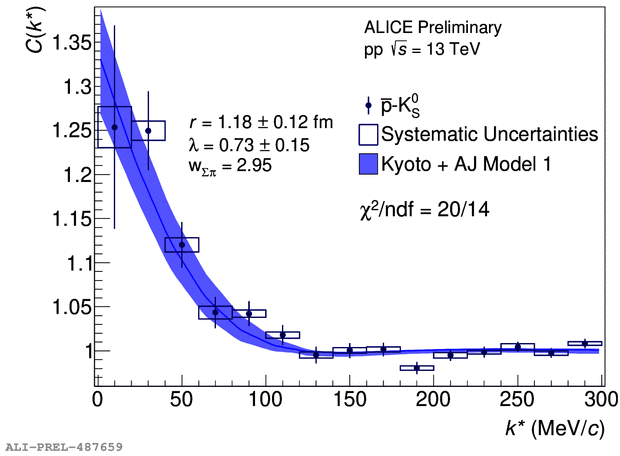
Experimental femtoscopic correlation function of K0s-Antip pairs measured in minimum bias pp collisions at $\sqrt{s}=13$ TeV. The statistical uncertainties are represented by the error bars, while the boxes represent the systematic uncertainties obtained with the variation of the K0s and p selection criteria. The blue line represents the fit performed with the Kyoto model (for AntiK0p system) and Aoki-Jido Model 1 (for the K0p system).
The theoretical wave function for the AntiK0p system was obtained through the effective AntiKN−πΣ−πΛ coupled channel potential (K. Miyahara, T. Hyodo, and W. Weise, Phys. Rev. C98, 025201 (2018), 1804.08269; Y.Kamiya, T.Hyodo, K.Morita, A.Ohnishi and W.Weise, Phys. Rev. Lett. 124 (2020) no.13,132501) and the weight of the sigma pi coupled channel is fixed at 2.95, while the weight is fixed at 1 for the other coupled channels. The K0p system has the K$^+$n coupled channel below threshold an its wave function was obtained using the Aoki-Jido model (Kenji Aoki and Daisuke Jido. PTEP, 2019(1):013D01, 2019) based on the chiral dynamics. For the comparison in this plot the AJ 1 solution is used. The particles’ source is assumed to be gaussian and it’s radius is fixed at 1.18 fm (ALICE Collaboration Phys.Rev.Lett. 124 (2020) no.9, 092301). This fit compares the experimental data to the models derived from chiral effective theory. The systematic uncertainty on the femtoscopic fit is represented by the blue band that was obtained by varying the fixed parameters in the fit function.
K0s candidates selections:
-Track selections: minimum #clusters >70, #crossed rows over findable >0.8
-Topological and kinematic selections: 3sigma TPC $\pi$, DCA V0 daughters <0.8 cm, Pseudorapidity V0 daughters <0.8, K0s rapidity <0.5, K0s $c\tau$< 7*$c\tau^{nom}_{K0s}$, DCA1 >0.1 cm, DCA2 > 0.1 cm, V0 cosine of pointing angle >0.98, $|M_{\Lambda} - M^{nom}_{\Lambda}|>0.005 ~\mathrm{GeV/c^2}$, $|M_{\overline{\Lambda}} - M^{nom}_{\overline{\Lambda}}|>0.005 ~ \mathrm{GeV/c^2}$, $|M_{K0s} - M^{nom}_{K0s}| <0.016 ~ \mathrm{GeV/c^2}$.
Proton and antiproton selections:
-Track selections: aodtrack with filterbit 4, minimum #clusters >70, #crossed rows over findable >0.8
Kinematic and geometric selections: pseudorapidity < 0.8, DCAz <0.5 cm, DCAxy <0.1 cm, $ |M^{tof}_{p}-M^{nom}_p| < 0.08 ~ \mathrm{GeV/c^2} $.
Analysed datasets:
-Experimental data (AOD234): LHC16d, LHC16p, LHC16e, LHC16g, LHC16h, LHC16i, LHC16j, LHC16k, LHC16l, LHC16o, LHC17c,LHC17e, LHC17f, LHC17i, LHC17j, LHC17k, LHC17l, LHC17m, LHC17o, LHC17r, LHC17h, LHC18b, LHC18m, LHC18n, LHC18k, LHC18o, LHC18p, LHC18d, LHC18e, LHC18f, LHC18g, LHC18h, LHC18i, LHC18j, LHC18l
-Monte Carlo simulations: LHC18a1 (anchored to LHC17r), LHC18a8 (anchored to LHC17l), LHC18a9 (anchored to LHC17o), LHC18c12 (anchored to LHC17h), LHC18c13 (anchored to LHC17k), LHC18g4 (anchored to LHC18b), LHC18f1 (anchored to LHC16k), LHC18j4 (anchored to LHC18m), LHC18h4 (anchored to LHC18g), LHC17f5extra (anchored to LHC16h), LHC17l5 (anchored to LHC17m), LHC17k4 (anchored to LHC17i), LHC17h11 (anchored to LHC17j), LHC18c12bextra (anchored to LHC17h), LHC20f2 (anchored to LHC16d)
